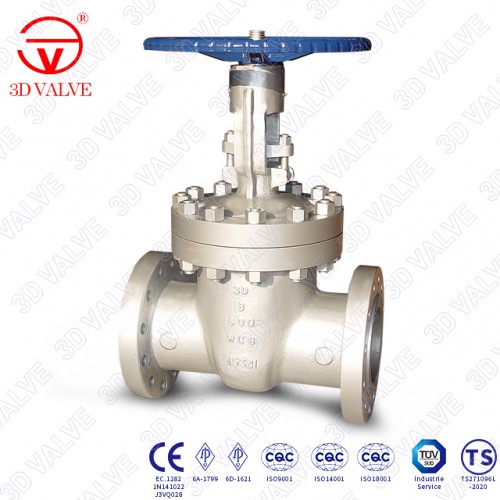

3D gate valves are reliable, offering a tight shut-off and low pressure drop. The design covers a wide range of requirements to meet any customer need from general to severe service conditions.
3D gate valves are in compliance with the latest edition of API600 and ASME B16.34.
Size: NPS 2"~66"(DN50~DN1650)
Pressure Rating: ASME Class150~2500(PN16~PN420)
Body material:Carbon steel, Stainless steel, Alloy steel, Duplex stainless steel
End connection:RF, BW, RTJ
Operation:Manual, Pneumatic, Electric, Hydraulic
The opening and closing part of the high-temperature gate valve is the gate, and the movement direction of the gate is perpendicular to the fluid direction. The gate valve can only be fully opened and closed, not adjusted and throttled. The ram has two sealing surfaces. The most commonly used mode is that the two sealing surfaces of the ram valve form a wedge, and the wedge angle varies with the valve parameters. Generally, when the medium temperature is not high, it is 2 ° 52 '. The gate of wedge gate valve can be made into a whole, which is called rigid gate valve; It can also be made into a ram that can produce slight deformation to improve its manufacturability and make up for the deviation of the angle of the sealing surface in the processing process. This kind of ram is called elastic ram.
The types of gate valves can be divided into wedge gate valve and parallel gate valve according to the configuration of sealing surface. Wedge gate valve can be divided into single gate plate, double gate plate and elastic gate valve; Parallel gate valves can be divided into single gate plate and double gate plate. According to the thread position of the valve stem, it can be divided into rising stem gate valve and Non rising stem gate valve.
When the high-temperature gate valve is closed, the sealing surface can be sealed only by the medium pressure, that is, the sealing surface of the gate valve can be pressed to the valve seat on the other side by the medium pressure to ensure the sealing of the sealing surface, which is self sealing. Most gate valves are forced sealed, that is, when the valve is closed, the gate shall be forced to the valve seat by external force to ensure the tightness of the sealing surface.
The gate of high-temperature gate valve moves in a straight line with the valve stem, which is called lifting rod gate valve (also known as rising rod gate valve). Generally, there are trapezoidal threads on the lifting rod. Through the nut at the top of the valve and the guide groove on the valve body, the rotary motion is changed into linear motion, that is, the operating torque is changed into operating thrust.
When the valve is opened, when the lifting height of the ram is equal to 1:1 times the valve diameter, the fluid channel is completely unblocked, but this position cannot be monitored during operation. In actual use, the vertex of the valve stem is used as the mark, that is, the position that cannot be opened is used as its fully open position. In order to consider the locking phenomenon caused by temperature change, it is usually opened to the peak position and then turned back 1 / 2-1 turn as the position of fully open valve. Therefore, the fully open position of the valve is determined according to the position (i.e. stroke) of the ram.
For some gate valves, the valve stem nut is set on the ram, and the rotation of the hand wheel drives the valve stem to rotate and lift the ram. This kind of valve is called rotary rod gate valve or non-stop rod gate valve.